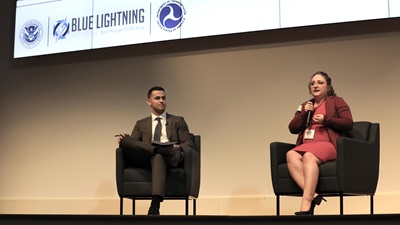Pilots asked to help fight human trafficking
Bringing GA into the conversation
Federal law enforcement and security officials are expanding the scope of a program designed to combat human trafficking to encourage active participation by members of the general aviation community.
The U.S. Department of Homeland Security hosted aviation industry professionals on January 26 for the Combating Human Trafficking in Aviation Summit with the Blue Lightning Initiative, an element of the Blue Campaign—a DHS push to promote public, law enforcement, and industry awareness about indicators of human trafficking and appropriate responses when encountering it.
One afternoon panel, hosted by Michael Camal, senior advisor of the Blue Lightning Initiative, focused specifically on the ways traffickers take advantage of general and private aviation to subvert law enforcement. Panelists from government agencies and private organizations each talked about their unique perspectives on human trafficking in GA and highlighted their efforts to combat the issue.
While similarities in human trafficking crimes exist between commercial aviation and GA, there are several factors that prompt traffickers to prefer private and GA airports. According to Ryan Sieg, special agent at Homeland Security Investigations and program manager at the Center for Countering Human Trafficking at DHS, smaller airports can be targeted by criminals mainly for security reasons. Large, commercial airports have police and Transportation Security Agency staff. Smaller airports are "often not staffed after hours and [traffickers] use those vulnerabilities…to gain privacy and hide the crime," Sieg said.
The sentiment was echoed by fellow panelist Kyle Herbig, vice president of airport solutions at the American Association of Airport Executives. "The difference is the resources they have to combat and mitigate these threats," Herbig said. GA airports "don't have the same fiscal heft that commercial service airports do."
 Since private and GA airports follow a "see something, say something" culture, it's important for community members at these smaller airports to know what they should be looking for and how to identify what they're seeing.
Since private and GA airports follow a "see something, say something" culture, it's important for community members at these smaller airports to know what they should be looking for and how to identify what they're seeing.
Herbig continued with encouragement that the Blue Lightning Initiative is the best way to mitigate these threats, as it can help "enforce a training culture of awareness of this topic" for staff and those who use the airports.
Joe Dalton, vice president of security and operations at the National Air Transportation Association Compliance Services—spoke about how GA airports are places of opportunity for traffickers. There are approximately 15,000 private jets in the United States and 146,000 fixed-wing private aircraft. "All of that, unfortunately, could be an opportunity for human trafficking," Dalton said.
However, there are also opportunities to fight back. Pilots, line workers, luggage handlers, and FBO staff potentially have their eyes on every aircraft. "All of those are opportunities for training and also opportunities that they could see something and take action," Dalton said.
The earliest versions of Blue Lightning Initiative training were commercial airline-driven. After feedback from partners and participants, the most recent version has expanded to bring the GA community into the conversation, which makes it a more valuable resource for aircraft owners, pilots, and staff at GA airports.
If you're interested in bringing Blue Lightning Initiative training to your airport or organization, email [email protected]. "There are plenty of resources available if the initiative is there," said Herbig.




